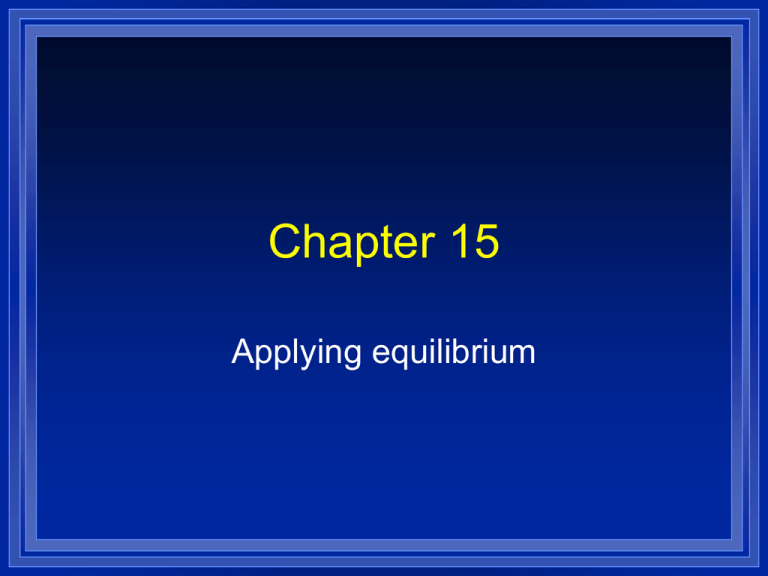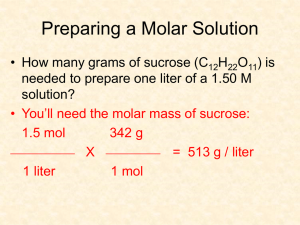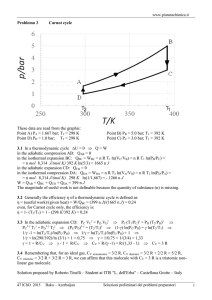Chapter 15
advertisement

Chapter 15 Applying equilibrium The Common Ion Effect When the salt with the anion of a weak acid is added to that acid, Lowers the percent dissociation of the acid. Ex: NaF and HF mixed together – F- is the common ion HF ↔ H+ + FAdding F- shifts the equilibrium to the left and therefore fewer H+ ions present The same principle applies to salts with the cation of a weak base. The calculations are the same as last chapter. NH4Cl and NH3 (NH4+ is the common ion) NH3 + H+ NH4+ Buffered solutions A solution that resists a change in pH. Consists of either a weak acid and its salt or a weak base and its salt. We can make a buffer of any pH by varying the concentrations of these solutions. Same calculations as before. Calculate the pH of a solution that is .50 M HAc and .25 M NaAc (Ka = 1.8 x 10-5) Na+ is a spectator and the reaction we are worried about is HAc H+ + AcInitial 0.50 M Change -x Final 0.50-x 0 x x Choose x to be small We can fill in the table 0.25 M x 0.25+x HAc Initial 0.50 M Change -x Final H+ + 0 x Ac0.25 M x 0.50-x x 0.25+x Do the math Ka = 1.8 x 10-5 x (0.25) x (0.25+x) = 1.8 x 10-5 = (0.50) (0.50-x) Assume x is small x = 3.6 x 10-5 Assumption is valid pH = -log (3.6 x 10-5) = 4.44 Adding a strong acid or base Do the stoichiometry first. – Use moles not molar A strong base will grab protons from the weak acid reducing [HA]0 A strong acid will add its proton to the anion of the salt reducing [A-]0 Then do the equilibrium problem. What is the pH of 1.0 L of the previous solution when 0.010 mol of solid NaOH is added? HAc H+ + Ac- 0.25 mol 0.50 mol 0.26 mol 0.49 mol In the initial mixture M x L = mol 0.50 M HAc x 1.0 L = 0.50 mol HAc 0.25 M Ac- x 1.0 L = 0.25 mol Ac Adding 0.010 mol OH- will reduce the HAc and increase the Ac- by 0.010 mole Because it is in 1.0 L, we can convert it to molarity HAc H+ + Ac- 0.25 mol 0.50 mol 0.26 M 0.49 M In the initial mixture M x L = mol 0.50 M HAc x 1.0 L = 0.50 mol HAc 0.25 M Ac- x 1.0 L = 0.25 mol Ac Adding 0.010 mol OH- will reduce the HAc and increase the Ac- by 0.010 mole Because it is in 1.0 L, we can convert it to molarity HAc H+ + Ac0.25 mol 0.26 M 0.50 mol 0.49 M Fill in the table HAc H+ + Initial 0.49 M -x x Final x 0.49-x 0 Ac0.26 M x 0.26+x HAc Initial 0.49 M -x Final H+ + 0 x Ac0.26 M x 0.49-x x 0.26+x Do the math Ka = 1.8 x 10-5 x (0.26) x (0.26+x) = 1.8 x 10-5 = (0.49) (0.49-x) Assume x is small x = 3.4 x 10-5 Assumption is valid pH = -log (3.4 x 10-5) = 4.47 Notice If we had added 0.010 mol of NaOH to 1 L of water, the pH would have been. 0.010 M OH pOH = 2 pH = 12 But with a mixture of an acid and its conjugate base the pH doesn’t change much Called a buffer. General equation Ka = [H+] [A-] [HA] so [H+] = Ka [HA] [A-] The [H+] depends on the ratio [HA]/[A-] taking the negative log of both sides pH = -log(Ka [HA]/[A-]) pH = -log(Ka)-log([HA]/[A-]) pH = pKa + log([A-]/[HA]) This is called the HendersonHasselbach equation pH = pKa + log([A-]/[HA]) pH = pKa + log(base/acid) Works for an acid and its salt Like HNO2 and NaNO2 Or a base and its salt Like NH3 and NH4Cl But remember to change Kb to Ka Calculate the pH of the following 0.75 M lactic acid (HC3H5O3) and 0.25 M sodium lactate (Ka = 1.4 x 10-4) 0.25 M pH = -log(1.4 x 10 ) + log 0.75 M -4 pH = 3.38 Calculate the pH of the following 0.25 M NH3 and 0.40 M NH4Cl (Kb = 1.8 x 10-5) Ka = 1 x 10-14 1.8 x 10-5 Ka = 5.6 x 10-10 remember its the ratio base over acid 0.25 M pH = -log(5.6 x 10 ) + log 0.40 M -10 pH = 9.05 Prove they’re buffers What would the pH be if .020 mol of HCl is added to 1.0 L of both of the preceding solutions. What would the pH be if 0.050 mol of solid NaOH is added to 1.0 L of each of the proceeding. Remember adding acids increases the acid side, Adding base increases the base side. Prove they’re buffers What would the pH be if .020 mol of HCl is added to 1.0 L of preceding solutions. 0.75 M lactic acid (HC3H5O3) and 0.25 M sodium lactate (Ka = 1.4 x 10-4) HC3H5O3 H+ + C3H5O3 Initially After acid 0.75 mol 0.77 mol 0 0.25 mol 0.23 mol 0.23 M pH = -log(1.4 x 10 ) + log 3.33 0.77 M -4 Compared to 3.38 before acid was added Prove they’re buffers What would the pH be if 0.050 mol of solid NaOH is added to 1.0 L of the solutions. 0.75 M lactic acid (HC3H5O3) and 0.25 M sodium lactate (Ka = 1.4 x 10-4) HC3H5O3 H+ + C3H5O3 Initially After acid 0.75 mol 0.70 mol 0 0.25 mol 0.30 mol 0.30 M pH = -log(1.4 x 10 ) + log 3.48 0.70 M -4 Compared to 3.38 before acid was added Prove they’re buffers What would the pH be if .020 mol of HCl is added to 1.0 L of preceding solutions. 0.25 M NH3 and 0.40 M NH4Cl Kb = 1.8 x 10-5 so Ka = 5.6 x 10-10 NH4+ H+ + NH3 Initially 0.40 mol 0 0.25 mol After acid 0.42 mol 0.23 mol 0.23 M pH = -log(5.6 x 10 ) + log 8.99 0.42 M -10 Compared to 9.05 before acid was added Prove they’re buffers What would the pH be if 0.050 mol of solid NaOH is added to 1.0 L each solutions. 0.25 M NH3 and 0.40 M NH4Cl Kb = 1.8 x 10-5 so Ka = 5.6 x 10-10 NH4+ H+ + NH3 Initially 0.40 mol 0 0.25 mol After acid 0.35 mol 0.30 mol 0.30 M pH = -log(5.6 x 10 ) + log 9.18 0.35 M -10 Compared to 9.05 before acid was added Buffer capacity The pH of a buffered solution is determined by the ratio [A-]/[HA]. As long as this doesn’t change much the pH won’t change much. The more concentrated these two are the more H+ and OH- the solution will be able to absorb. Larger concentrations = bigger buffer capacity. Buffer Capacity Calculate the change in pH that occurs when 0.040 mol of HCl(g) is added to 1.0 L of each of the following: 5.00 M HAc and 5.00 M NaAc 0.050 M HAc and 0.050 M NaAc Ka= 1.8x10-5 5.00 M pH = -log(1.8 x 10 ) + log 4.74 5.00 M -5 pH = pKa Buffer Capacity Calculate the change in pH that occurs when 0.040 mol of HCl(g) is added to 1.0 L of 5.00 M HAc and 5.00 M NaAc Ka= 1.8x10-5 HAc H+ + AcInitially 5.00 mol 0 5.00 mol After acid 5.04 mol 4.96 mol 4.96 M pH = -log(1.8 x 10 ) + log 4.74 5.04 M -5 Compared to 4.74 before acid was added Buffer Capacity Calculate the change in pH that occurs when 0.040 mol of HCl(g) is added to 1.0 L of 0.050 M HAc and 0.050 M NaAc Ka= 1.8x10-5 HAc H+ + AcInitially 0.050 mol 0 0.050 mol After acid 0.090 mol 0 0.010 mol 0.010M pH = -log(1.8 x 10 ) + log 3.79 0.090 M -5 Compared to 4.74 before acid was added Buffer capacity The best buffers have a ratio [A-]/[HA] = 1 This is most resistant to change True when [A-] = [HA] Makes pH = pKa (since log 1 = 0) Titrations Titrations Millimole (mmol) = 1/1000 mol Molarity = mmol/mL = mol/L Makes calculations easier because we will rarely add liters of solution. Adding a solution of known concentration until the substance being tested is consumed. This is called the equivalence point. Where moles of acid = moles of base Strong acid with strong Base Equivalence at pH 7 pH 7 mL of Base added Weak acid with strong Base Equivalence at pH >7 pH >7 7 mL of Base added Strong base with strong acid Equivalence at pH 7 pH 7 mL of acid added Weak base with strong acid Equivalence at pH <7 pH 7 <7 mL of acid added Strong acid with Strong Base Do the stoichiometry. mL x M = mmol There is no equilibrium . They both dissociate completely. The reaction is H+ + OH- HOH Use [H+] or [OH-] to figure pH or pOH The titration of 20.0 mL of 0.10 M HNO3 with 0.10 M NaOH Weak acid with Strong base There is an equilibrium. Do stoichiometry. – Use moles Determine major species Then do equilibrium. Calculate the pH after 0.0mL, 15.0mL, 25.0 mL, and 30.0mL of 0.10 M NaOH are added to 25.0mL of 0.10M of Nicotinic acid Ka= 1.4 x 10 -5 Summary Strong acid and base just stoichiometry. Weak acid with 0 ml of base - Ka Weak acid before equivalence point –Stoichiometry first –Then Henderson-Hasselbach Weak acid at equivalence point- Kb -Calculate concentration Weak acid after equivalence - leftover strong base. -Calculate concentration Example A 25.0 mL sample of benzoic acid (0.120M) is titrated w/ NaOH (.210 M) Ka= 6.3 x 10 -5 – Calculate # moles of Benzoic acid – Calculate volume of NaOH needed to reach equiv. pt – Calc. the pH before any base is added – Calc. pH after 10ml base is added – Find the pH at equivalence pt – Calculate the pH after 15.3mL of OH- is added Summary Weak base before equivalence point. –Stoichiometry first –Then Henderson-Hasselbach Weak base at equivalence point Ka. -Calculate concentration Weak base after equivalence – left over strong acid. -Calculate concentration Titrate 50.0 mL of 0.10 M HF (Ka = 7.2 x 10-4) with 0.10 M NaOH Indicators Weak acids that change color when they become bases. weak acid written HIn Weak base HIn H+ + Inclear red Equilibrium is controlled by pH End point - when the indicator changes color. Try to match the equivalence point Indicators Since it is an equilibrium the color change is gradual. It is noticeable when the ratio of [In-]/[HI] is 1/10 or [HI]/[In-] is 10/1 Since the Indicator is a weak acid, it has a Ka. pH the indicator changes is pH=pKa +log([In ]/[HI]) = pKa +log(1/10) pH=pKa - 1 Indicators pH=pKa + log([HI]/[In-]) = pKa + log(10) pH=pKa+1 Choose the indicator with a pKa 1 more than the pH at equivalence point if you are titrating with base. Choose the indicator with a pKa 1 less than the pH at equivalence point if you are titrating with acid. Sample Problem Two drops of indicator HIn (Ka= 1.0 x 10 -9), hwere HIn is yellow and In- is blue are placed in 100.0 mL of 0.10 M HCl. – What color is the solution initially? – The solution is titrated with 0.10 M NaOH. At what pH will the color change (greenish yellow) occur? – What color will the solution be after 200.0mL of NaOH has been added? What color will the solution be after 200.0mL of NaOH has been added? Solubility Equilibria Will it all dissolve, and if not, how much? All dissolving is an equilibrium. If there is not much solid it will all dissolve. As more solid is added the solution will become saturated. Solid dissolved The solid will precipitate as fast as it dissolves . Equilibrium General equation M+ stands for the cation (usually metal). Nm- stands for the anion (a nonmetal). MaNmb(s) aM+(aq) + bNm- (aq) Remember the concentration of a solid doesn’t change. So, what’s the K expression? Ksp = [M+]a[Nm-]b Called the solubility product for each compound. Watch out Solubility is not the same as solubility product. Solubility product is an equilibrium constant. it doesn’t change except with temperature. Solubility is an equilibrium positionusually expressed as a Molarity for how much can dissolve. Calculating Solubility Ex: Calc. Solubility of CaC2O4 if the value of Ksp= 4.8 x 10 -5 mol/L CaC2O4 (s) ↔ Ca+2(aq) + C2O4 -2 (aq) Ksp = [Ca+2] [C2O4-2] Ksp= [s] [s] = [s]2 = 4.8x10-5 = s2 s= 6.9 x 10 -3 M Calculating Ksp The solubility of copper(I) bromide is 2.0 x 10 -4 mol/L. Calc. Ksp value. CuBr(s) ↔ Cu+1(aq) + Br-1 (aq) I .0002M 0M 0M C - .0002M +.0002M +.0002M E 0 .0002M .0002M Ksp = [.0002] [.0002] = 4.0 x 10 -8 (units usually omitted) The solubility of Calcium Carbonate is 8.7 x 10 -9 mol/L. Calc. Ksp. Calculating Ksp The solubility of iron(II) oxalate FeC2O4 is 65.9 mg/L The solubility of Li2CO3 is 5.48 g/L Common Ion Effect If we try to dissolve the solid in a solution with either the cation or anion already present less will dissolve. Calculate the solubility of SrSO4, with a Ksp of 3.2 x 10-7 in M in a solution of 0.010 M Na2SO4. Calculate the solubility of CaF2 Ksp= 4.0 x 10 -11 in a 0.025 M NaF solution. AgCl and NaCl in solution Cl- is the common ion When [Ag+] [Cl-] < Ksp, no precipitate will be formed. When [Ag+] [Cl-] > Ksp, a precipitate will be formed. pH and solubility OH- can be a common ion. More soluble in acid. For other anions if they come from a weak acid they are more soluble in a acidic solution than in water. CaC2O4 Ca+2 + C2O4-2 H+ + C2O4-2 HC2O4 Reduces [C2O4-2] in acidic solution. Sample problem What is the pH in a saturated solution of Ca(OH)2? Ksp = 5.5 x 10-6 for Ca(OH)2. Q and Precipitation not necessarily at Equil. Q= Ion product Q =[M+]a[Nm-]b If Q>Ksp a precipitate forms. (supersaturated) If Q<Ksp No precipitate. (unsaturated) If Q = Ksp equilibrium. (saturated) Example1 Chemical analysis gave [Pb2+] = 0.012 M, and [Br-] = 0.024 M in a solution. From a table, you find Ksp for PbBr2 has a value of 4x 10-5. Is the solution saturated, oversaturated or unsaturated? Example 2 A solution of 750.0 mL of 4.00 x 10-3M Ce(NO3)3 is added to 300.0 mL of 2.00 x 10-2M KIO3. Will Ce(IO3)3 (Ksp= 1.9 x 10-10M) precipitate and if so, what is the concentration of the ions? Selective Precipitations Used to separate mixtures of metal ions in solutions. Add anions that will only precipitate certain metals at a time. Used to purify mixtures. Often use H2S because in acidic solution Hg+2, Cd+2, Bi+3, Cu+2, Sn+4 will precipitate. Selective Precipitation Then add OH-solution [S-2] will increase so more soluble sulfides will precipitate. Co+2, Zn+2, Mn+2, Ni+2, Fe+2, Cr(OH)3, Al(OH)3 Selective precipitation Follow the steps First with insoluble chlorides (Ag, Pb, Ba) Then sulfides in Acid. Then sulfides in base. Then insoluble carbonate (Ca, Ba, Mg) Alkali metals and NH4+ remain in solution. Complex ion Equilibria A charged ion surrounded by ligands. Ligands are Lewis bases using their lone pair to stabilize the charged metal ions. Common ligands are NH3, H2O, Cl-,CN Coordination number is the number of attached ligands. Cu(NH3)42+ has a coordination # of 4 The addition of each ligand has its own equilibrium Usually the ligand is in large excess. And the individual K’s will be large so we can treat them as if they go to completion. The complex ion will be the biggest ion in solution. Calculate the concentrations of Ag+, Ag(S2O3)-2, and Ag(S2O3)2-3 in a solution made by mixing 150.0 mL of 0.010 M AgNO3 with 200.0 mL of 5.00 M Na2S2O3 Ag+ + S2O3-2 Ag(S2O3)K1=7.4 x 108 Ag(S2O3)- + 2S2O3-2 Ag(S2O3)2-3 K2=3.9 x 104 (Hint: set up ice problem, determine L.R.) This problem is found on pg. 768-769 in your book. Check your work! Complex Ions and Solubility The dissolving of solid AgCl in excess NH3 is represented as… AgCl(s) + 2NH3(aq) ↔ Ag(NH3)2+ (aq) + Cl- (aq) However, this is a result of several steps AgCl(s) ↔ Ag+ + ClKsp= 1.6 x 10-10 Ag+ + NH3 ↔ Ag(NH3)+ K1 = 2.1 x 103 Ag(NH3)+ + NH3 ↔ Ag(NH3)2+ K2= 8.2 x 103 AgCl(s) + 2NH3(aq) ↔ Ag(NH3)2+ (aq) + Cl- (aq) So the Equilibrium Expression is written as…. K= [Ag(NH3)2+] [Cl-] [NH3]2 = Ksp x K1 x K2 = (1.6 x 10-10) ( 2.1 x 103) (8.2 x 103) = 2.8 x 10-3 Summary 3 Factors that affect solubility: - Common Ions - pH - Complexing Agents/Ions Mixtures of Ions can be separated by selective precipitation (you know this as Quantitative Analysis) - Steps listed on pg.765 or in your lab








